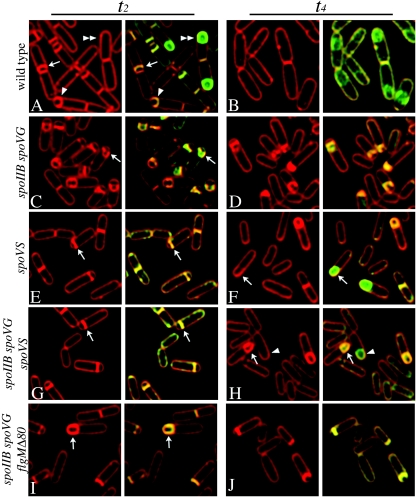FIG. 2.
Effect of the spoVS mutation on engulfment. Sporulation was induced by resuspension (33), and samples taken 2 h (t2) (A, C, E, G, and I) and 4 h (t4) (B, D, F, H, and J) later were stained with FM 4-64 (red) and MitoTracker Green (green) as previously described (24, 29). (A and B) Wild-type (PY79) sporangia after septation (arrow) and during engulfment (arrowhead). The septum stains approximately two times more brightly than the cytoplasmic membrane, because it contains two parallel membranes, while the engulfing membrane stains approximately three times more brightly, because it contains three membrane layers (Fig. 1A) (24). After membrane fusion (double arrowhead), FM 4-64 is excluded from the forespore (29), which is stained only with MitoTracker Green. (C and D) The spoIIB spoVG double mutant (KP52) shows sporangia with flat polar septa or bulges (arrow). (E and F) The spoVS mutant (KP535) is delayed in polar septation but engulfs normally (E, arrow) and completes membrane fusion (F, arrow). (G and H) The spoIIB spoVG spoVS triple mutant (KP787) exhibits few bulges (G, arrow) and completes membrane migration (H, arrow) and fusion (H, arrowhead). (I to J) The spoIIB spoVG flgMΔ80 triple mutant (KP815) shows few bulges and completes engulfment (I, arrow).

